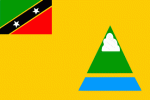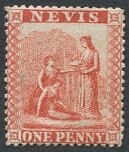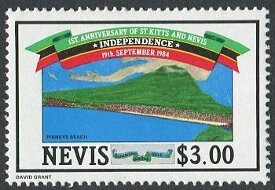
Nevis
Leeward Islands

Nevis
Saint Kitts & Nevis
Quick reference
General issues: Presidency Leeward Islands 1861-1882, Postal Area Saint Kitts & Nevis 1882-1890, Postal Area Saint Kitts & Nevis/Associated state 1980-1983, Postal area Saint Kitts & Nevis/Independent within the British Commonwealth 1883-Present
Country name on general issues: Nevis
Currency: 1 Pound = 20 Shilling, 1 Shilling = 12 Pence 1870-1890, 1 Dollar = 100 Cent 1980-Present
Population: 11 700 in 1871, 11 100 in 2001
Political history Nevis
Nevis is located in the Caribbean as one of the Lesser Antilles – for the exact location, please refer to the map of the Caribbean. Prior to colonization, the island was inhabited by the Amerindian Carib people that are found on many of the Lesser Antilles. The first European to sight the island was Christopher Columbus in 1493. The first permanent settlement was established by the British in 1628 from neighboring Saint Kitts. France sought to gain possession of Nevis twice in the 18th century, but recognized British sovereignty in 1783. Nevis would, from the 17th until the 20th century, almost continuously, be administered as part of the Leeward Islands colony – the federal colony that grouped together the British possessions in the Leeward Islands. From 1871, Nevis was formally designated as a presidency of the Leeward Islands. Shortly after, in 1883, Nevis was grouped together with Saint Kitts and its dependency Anguilla as the presidency of Saint Kitts & Nevis, renamed Saint Kitts, Nevis & Anguilla in 1952. A grouping that would lead to much dispute as both Anguilla and Nevis resented being joined with Saint Kitts.
The presidency of Saint Kitts, Nevis & Anguilla existed until the Leeward Islands colony was dissolved in 1956 and the presidency became a separate colony. As such, Saint Kitts, Nevis & Anguilla, between 1958 and 1962, joined the West Indies Federation – a short lived federation of most of the British possessions in the West Indies. In 1967, Saint Kitts, Nevis & Anguilla became an associated state. Anguilla revolted and ultimately was granted the de jure status of a separate British dependency in 1980. Consequently, Saint Kitts, Nevis & Anguilla was, in 1980, renamed Saint Kitts & Nevis and would, as such, gain independence within the British Commonwealth in 1983. Nevis was, by way of the 1983 constitution, granted a large degree of self government and the right to secede. Secessionist sympathies are strong on Nevis. In a 1998 referendum more than 60% voted for secession – just short of the two-thirds majority required.
Economically, the British, from the 17th century, developed sugar cane plantations on Nevis. To man the plantations, slaves were brought from Africa. Nevis developed and became one of the wealthiest British colonies, until the sugar cane trade went into decline in the 19th century. Yet, sugar cane would remain the main economic activity until the late 20th century, when the focus was shifted to tourism, which is currently the most important sector of the economy. On the United Nations Human Development Index, Saint Kitts & Nevis rank as a High Development Country. The population is predominantly black.
Postal history Nevis
The first stamps used on Nevis were the general issues from Great Britain, which were used between 1858 and 1860. The first stamps for Nevis were issued in 1861. The first issues are of a design unique for Nevis showing three women at a medicinal spring. The issues, from 1879, show the portrait of Queen Victoria in a design that is standard for the British colonies. Although grouped together with Saint Kitts in 1882 to form Saint Kitts & Nevis, Nevis continued to issue stamps until 1890, when the stamps of Nevis were superseded by the issues of the Leeward Islands. Between 1890 and 1903, the stamps of the Leeward Islands were used exclusively. When, in 1903, the presidencies of the Leeward Islands again issued stamps, they were used concurrent with the issues of the Leeward Islands until 1956, Nevis would come to use the issues of Saint Kitts & Nevis and, from 1952, the issues of Saint Kitts, Nevis & Anguilla.
In 1980, Anguilla was de jure separated from Saint Kitts and Nevis. The large amount of self government, granted to Nevis in the newly formed state of Saint Kitts & Nevis, is reflected in the postal arrangements: since 1980 Saint Kitts and Nevis have each issued their own stamps as postal areas of Saint Kitts & Nevis. An arrangement that was continued after independence was gained in 1983. The issues of Nevis, since 1980, are mainly aimed at the thematic collectors market.
For an overview of the political and postal developments in the form of a diagram, please refer to the country diagram of the British Leeward Islands.
Album pages
← Previous page: Netherlands AntillesNext page: Nicaragua →




